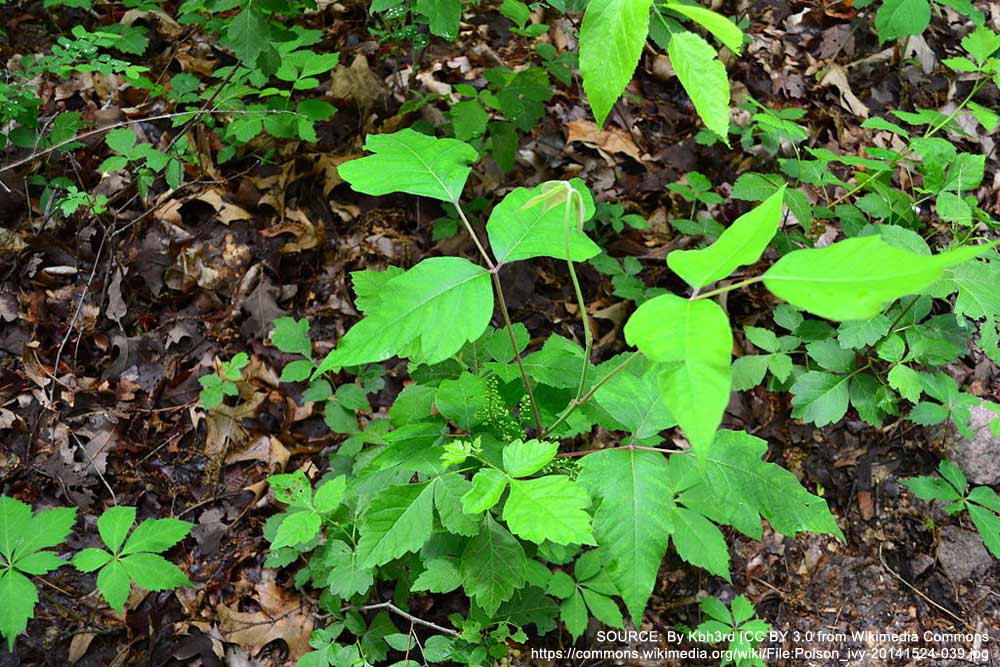Every summer these devilish little weeds seem to pop up everywhere and anywhere. Most people have no idea that they came in contact with the plant. There are two kinds of poison ivy, two kinds of poison oak, and one kind of poison sumac, which is not related to sumac trees. They are often difficult to identify in the wild. Poison ivy starts life as a red three leafed climbing vine. It climbs other bushes, and trees so prolifically it can literally replace the foliage on a bush or tree with its own, winning the battle for sunlight and nutrients. It can appear as though it is the naturally born foliage on that bush or tree, giving the appearance of a ‘poison ivy tree’.
Most people get the rash from touching leaves, while gardening, hiking, or looking for a ball lost in the weeds. The resin urushiol, the poison in poison ivy, comes off the plant leaves or from the stems, and can be passed to you touching a tool, from a pet, from clothing; from anything that has touched any of these plants. If you get a rash from ANY type of these plants it is called Rhus Dermatitis. The most dangerous way to come into contact with poison ivy, oak, or sumac is by breathing smoke from a fire burning any of those plants. This happens often in California brush fires. But people have gotten very sick from breathing smoke from campfires and fireplaces where these plants are burned.
About 15% of people are immune, and others can become immune. HOWEVER, you can gain or lose immunity, so to assume you can’t get it if you never have before is foolish. People change as they age. I would never assume that I was immune at any time no matter what my past experience was.
If you think you have come in contact with the plant you have only about 30 minutes to get the plant oil off of your skin before it soaks through the outer layers. Wash in COLD water, right away, with lots of pressure, like from a garden hose. It seems to take 8-24 hours for the rash to appear. But it depends on such factors as: how much oil you came into contact with; whether the oil got on areas of thin or thick skin; and your level of sensitivity. This variability is why the rash can seem to spread: it first appears where more oil got on the skin or where the skin was thinnest or scratched. Then areas with less oil or thicker skin start to erupt. The rash seems to last 2-3 weeks, depending on how much a person is exposed and how sensitive they are.
Dogs can get poison ivy on areas of skin that are not fur covered. Their fur seems to protect them from the plant oil, but the bare belly can get a rash. Birds eat the seeds with no problem, and goats and cows eat the leaves with no problem. People can get the rash from the fur of an animal that has rolled in the plant.
Treatment requires primarily steroids and antihistamines. They are the same medicines used for an allergic reaction. Steroids may be given orally, topically (cream or lotion), or by injection. Long acting steroid injections (DepoMedrol) are the best choice for bad cases because it can take 2-3 weeks to resolve. For moderate cases Prednisone tablets can do the trick, but need to be given for about 2 weeks. Steroid creams would be reserved for very mild cases, or as an adjunct additional steroid for bad cases where shots or pills are used also. Anti-histamines calm the itch but have the side effect of causing drowsiness. These may be administered in the same way the steroids are: injection, pills, or topically. Atarax (hydroxyzine) seems to work best of the tablet antihistamines in adults. Non-drowsy antihistamines such as Zyrtec, Allegra and Claritin may also work but are not quite as strong.
Zanfel is an over-the-counter product that claims to be the only poison ivy medication that actually molecularly degrades urushiol resin into 2 separate substances that can both be washed off the skin with water. If used properly it helps to limit the spread of the resin to other parts of the body. Urushiol resin is the substance that causes the allergic reaction, while our body’s own immune systems cause the rash. Urushiol is seen as a foreign invader on our skin which then triggers the immune system to cause large vesicles and bubbles with fluid in them in an attempt to either detoxify the resin or just get rid of it by sloughing off the skin.
Urushiol resin is extremely stable, and will stay active for many years in the right conditions, for example, on the underside of your lawnmower. You go to clean it out in the spring, forgetting that you used it in poison ivy last fall. And word is that a museum had 50-year old poison ivy samples which caused a rash when touched.

